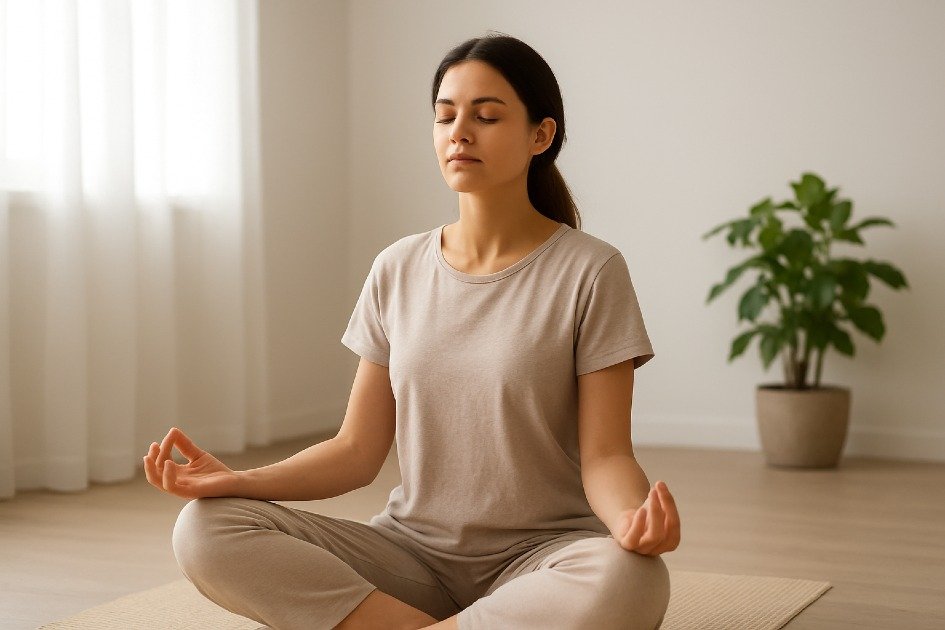Stress can quickly become a lifeline, drain energy and affect health. Consistent stress management can improve immunity, memory, and lifespan.
To maintain peace, it is essential to incorporate stress relief habits into your daily routine. These practices can stabilize your mind and restore balance, even in chaos.
Harvard Health recommends daily stress relief through relaxation techniques, sleep, exercise, and social connections.
By adopting these habits, you are not only focusing on relaxation but also protecting your future well-being.
These simple habits do not require extensive equipment or time, and gradually rewire your response to pressure, fostering resilience.
Whether you are a busy parent, a professional, or someone seeking stillness, each habit offers a pathway to steadiness.

Understanding Stress and Its Impact
Stress impacts body and mind, causing heart racing, muscle tightening, and thoughts spiraling. Understanding stress and using simple stress relief habits can calm body, clear mind, and protect health.
What Stress Really Does to Your Body and Mind
Stress triggers a “fight or flight” response, causing heart rate, muscle tightening, and shallow breathing. Long-term exposure can lead to headaches, poor sleep, and low focus.
Implementing simple stress relief habits like deep breathing, stretching, and herbal supplements can disrupt the stress cycle and reset the body’s alarm system over time.
After a long week, I took a morning walk. The fresh air cleared my head, eased the tightness in my shoulders, and quickly brought me back to balance.
The Difference Between Good Stress and Harmful Stress
Good stress, or eustress, motivates and builds resilience, while harmful stress keeps the nervous system overactive, leading to constant fatigue or emotional heaviness.
Recognizing the tipping point of stress is crucial for managing it effectively. Stress relief habits like meditation, journaling, and outdoor activities can help reset.
I have learned that pushing through stress and calling it “drive” only wears me down. When I pause for mindful breathing or step away from screens, I stay sharp and avoid burnout.
Why Stress Relief Is Essential for a Balanced Life
Unchecked stress negatively impacts long-term health, leading to high blood pressure, digestive issues, and weakened immunity. Building stress relief habits is crucial for maintaining quality of life.
Start small with simple solutions like reading calming books or replacing sugary snacks with balanced options, and each stress relief habit builds resilience.
Harvard Health suggests that building resilience against stress can be achieved through a balanced diet, regular exercise, and mindfulness practices.
I learned that when I made sleep and quiet time a priority, I gained more energy, became more patient, and managed life better. It showed me that calm is not luck, it is a skill anyone can build.
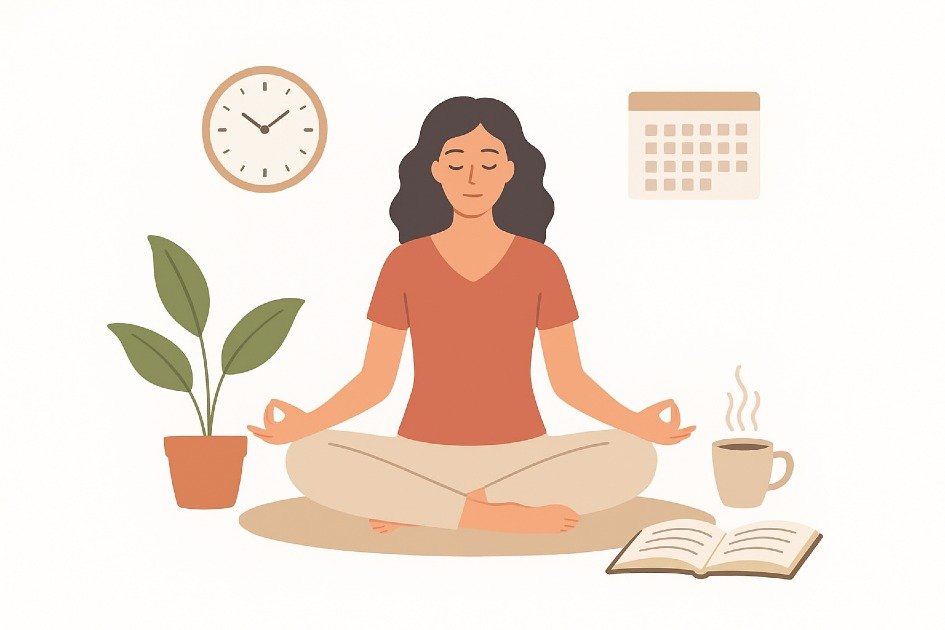
Morning Rituals That Set the Tone for Calm
A well-crafted morning routine not only improves focus, energy, and emotional resilience but also prepares the mind and body for stress, enhancing overall productivity and overall well-being.
Starting the Day with Deep Breathing or Meditation
Why it matters:
Stress starts early, but deep breathing or meditation can reduce cortisol levels, improve mental clarity, and prepare the body for mindful action.
How to do it:
- Choose a calm spot at home. Sit in a comfortable chair or on a meditation cushion to relax.
- Breathe in for 4 seconds, hold for two, and breathe out for six. Do this 5–10 times.
- Repeat one word, like “calm” or “peace,” to steady your mind and stop drifting thoughts.
- Slowly add time until you reach 10–15 minutes, only if it feels right for you.
Creating a No-Rush Morning Routine
Why it matters:
Rushing in the morning triggers stress hormones, causing anxiety. A deliberate routine reduces reactive decision-making, creating a stable mental foundation for tackling challenges with poise.
How to do it:
- Wake up 15–20 minutes earlier to give yourself extra time and start the day without rushing.
- Set out your clothes and prepare breakfast at night.
- Do one thing at a time—wash your face, make coffee, or write in your journal—slowly and with focus.
- Protect this moment—stay off emails and social media.
The Role of Gratitude in Reducing Daily Stress
Why it matters:
Gratitude is a stress-relieving habit that prioritizes positivity over worry, reduces mental clutter, boosts mood, and increases resilience against daily stressors, thereby enhancing overall satisfaction.
How to do it:
- Place a notebook by your bed to jot down thoughts or reminders before sleep.
- Every morning, list three things you are thankful for, no matter how small.
- Pick one idea and write a short reflection on why it matters to you.
- Share your gratitude with a friend or partner and spread positivity.
Integrating Movement to Wake Your Body
Why it matters:
Sedentary mornings cause stress, while gentle movement boosts circulation, releases endorphins, and prepares the body for mental clarity, improving alertness and emotional regulation within five minutes.
How to do it:
- Begin with simple moves: stretch tall, roll your shoulders, and loosen your back.
- Start your day with a quick 5–10-minute yoga flow or light workout to wake up your body and boost energy.
- Breathe deeply as you move to boost calm and relaxation.
Mindful Breakfast Choices
Why it matters:
Fueling your body effectively impacts mood and focus. A mindful breakfast stabilizes blood sugar, enhances cognitive function, and signals self-care, while skipping or rushing meals heightens anxiety and fatigue.
How to do it:
- Choose balance: eat whole grains, lean protein, and good fats.
- Put away screens and focus on your food. Enjoy every bite with full attention.
- Sip calming tea or lemon water with your meal. Herbal blends aid digestion and help you relax.
- Observe how different foods affect your mood and energy throughout the morning.
I noticed that starting my mornings with stress relief habits makes my entire day calmer and more focused. I began with one simple habit and kept practicing until it felt natural. Then I added another habit, these habits turned into a routine that keeps me balanced and clear-headed.
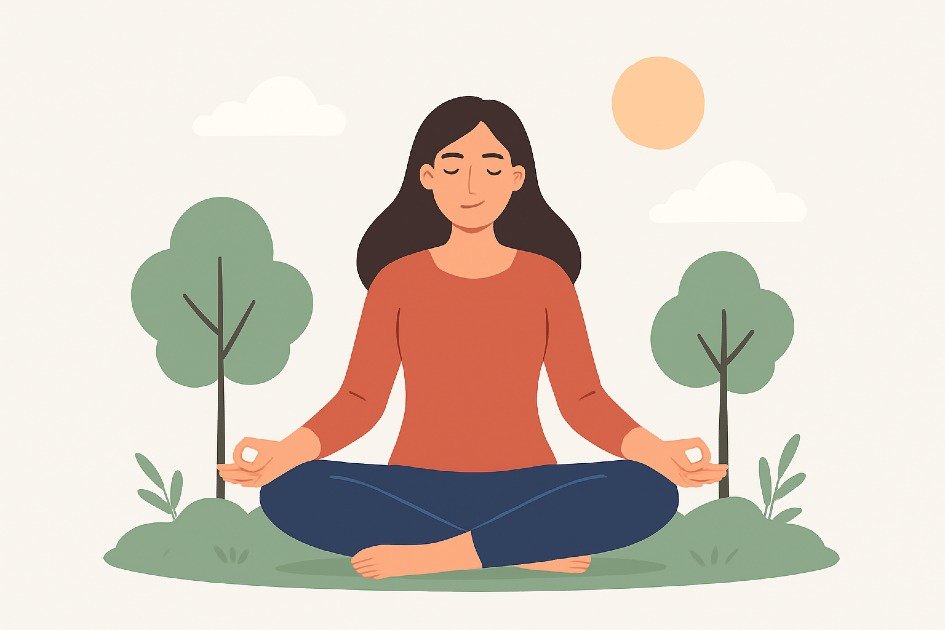
Mindful Practices to Stay Grounded
Mindfulness practices help reduce anxiety, distractions, and mental clutter, promoting calmness, focus, and emotional balance. Practical strategies can be integrated into daily life to achieve these benefits.
Simple Mindfulness Exercises You Can Do Anywhere
Why it matters:
Mindfulness improves mental clarity, reduces stress hormones, and enhances emotional resilience, making it a beneficial stress relief habit that can buffer against daily tension.
How to do it:
- Inhale and exhale slowly 3–5 times. Notice your chest move. Just half a minute can calm your body and mind.
- Pay attention to your surroundings without judging.
- Take a one-minute break. Close your eyes at your desk or on the bus and notice your thoughts as they pass.
I do not need to spend hours meditating to feel calmer. When I pause for just a few mindful minutes during my day—whether at my desk or in the kitchen—I notice my stress drop and my focus improve.
How Journaling Clears Mental Clutter
Why it matters:
Journaling helps release unspoken worries, reducing stress and promoting clarity, making it a stress relief habit that prevents mental overload and supports decision-making.
How to do it:
- Spend 5 minutes in the morning writing every thought in your head. Do not edit—just let it out.
- Write down three things you are thankful for each day. This simple habit trains your brain to notice the good and build a positive mindset.
- When stress hits, write the problem on paper. Then list three ways to fix it. This gives you control and eases anxiety.
When I write a journal each day, I turn my scattered thoughts into clear ideas, making my mind calmer and my day more organized.
Using Visualization to Shift Negative Thoughts
Why it matters:
Visualization, through the mind-body connection, can lower stress levels by imagining peaceful scenarios or achieving goals, enhancing confidence, focus, and resilience.
How to do it:
- Imagine a peaceful place—a quiet beach, a shady forest, or a cozy room. Notice the sounds, the textures, and the sights around you.
- Picture yourself managing a stressful moment with ease. Feel calm and successful as if it is happening right now.
- Add 2–3 minutes of visualization to your day—before breakfast, at lunch, or before bed—to build lasting focus and calm.
I picture calm in my mind, and over time, my brain learns to stay relaxed. This makes handling stress easier in real life.
Incorporating Mindful Walking
Why it matters:
Mindful walking enhances physical and mental health by grounding you in the present, releasing tension, improving circulation, and boosting energy levels.
How to do it:
- Walk slowly, feeling each step and how your feet touch the ground.
- Notice the sights, sounds, smells, and textures around you. Focus fully on the present moment.
- Pick a focus before walking. Choose a word like ‘peace’ or ‘calm’ and keep it in mind as you move.
Even five minutes of mindful walking between tasks can reset your mind, helping you approach challenges with clarity rather than tension.
Breathing Techniques to Center Your Mind
Why it matters:
Breathing regulates the nervous system, and when stressed, shallow breath signals fight-or-flight mode. Developing a breathing stress relief habit restores equilibrium and reduces anxiety.
How to do it:
- Box breathing: Breathe in for four counts, hold four, breathe out four, hold four. Do this 3–5 times to calm your mind and boost focus.
- Diaphragmatic breathing: Put one hand on your chest and one on your belly. Breathe deeply into your belly, keeping your chest still.
- 4-7-8 breathing: Breathe in for 4 seconds, hold for seven, and breathe out for eight. Use it before bed to quiet your mind and sleep better.
I use simple, quiet exercises to stay mindful and calm. They help me turn daily stress into peace. I can do them anywhere, and they make me feel healthier and more balanced every day.
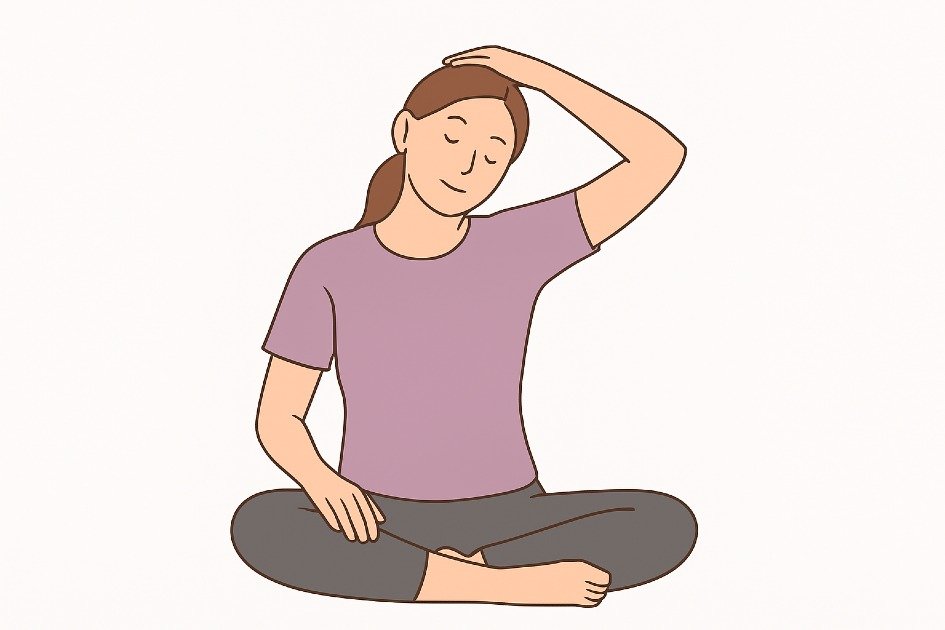
Movement That Eases Tension
Physical movement not only enhances exercise but also serves as a stress relief habit, releasing tension, energizing the mind, and promoting body communication calmness.
Gentle Stretches to Release Stress
Why it matters:
Gentle stretches help release tension in neck, shoulders, and back, improve circulation, and restore physical ease. They also signal the nervous system to relax, making them a powerful stress relief habit.
How to do it:
- Sit or stand tall. Slowly roll your shoulders forward and backward 10 times to improve posture and reduce tension.
- Reach your arms up as you breathe in, then lower them slowly as you breathe out.
- Perform a gentle neck stretch by tilting your head toward each shoulder and holding for ten seconds.
- Use a stretching mat or resistance band to improve flexibility and support your body.
Why Walking Is Nature’s Stress Reliever
Why it matters:
Walking is a stress-relieving habit that reduces cortisol levels and increases endorphins, providing a mental state reset and a stress relief routine that integrates seamlessly into daily life.
How to do it:
- Pick a calm spot—like a quiet path, park, or your backyard—to stay focused and avoid distractions.
- Pay attention to your breath and each step to stay present and calm
- Walk fast enough to raise your heart rate but slow enough to talk easily.
- Use a pedometer or fitness tracker to keep your daily steps consistent.
- Try joining walking groups or exploring nature trails to stay active and connect with others.
Low-Impact Workouts That Boost Mood Without Overwhelm
Why it matters:
Low-impact exercises like yoga, tai chi, and Pilates can provide a transformative stress relief habit by gently activating muscles, improving posture, increasing flexibility, and releasing tension efficiently.
How to do it:
- Begin your day with 15–20 minutes of guided yoga or tai chi to boost energy.
- Move slowly and with purpose, matching each breath to your motion.
- Do core exercises to improve posture and ease stress-related aches.
- Use yoga blocks or straps to stretch safely and comfortably.
- Set your sessions at the same time each day to make them a natural habit.
Incorporating Micro-Movements During Work
Why it matters:
Sitting for extended periods increases muscle stiffness and stress signals. Micro-movements, small intentional actions, counteract these effects, preventing tension accumulation and promoting energized body throughout the day.
How to do it:
- Take a break to stand and stretch every 30–60 minutes at work to boost energy, improve posture, and reduce muscle strain.
- Lift your legs or rotate your ankles while seated to keep blood flowing and prevent stiffness.
- Try shoulder shrugs and wrist stretches to ease built-up tension quickly.
- Place a desk pedal exerciser or stability ball at your desk to stay active while working.
- Pair micro-movements with deep breathing to amplify relaxation benefits.
I make movement part of my day, using it to ease stress and stay calm, focusing on steady progress, not perfection.
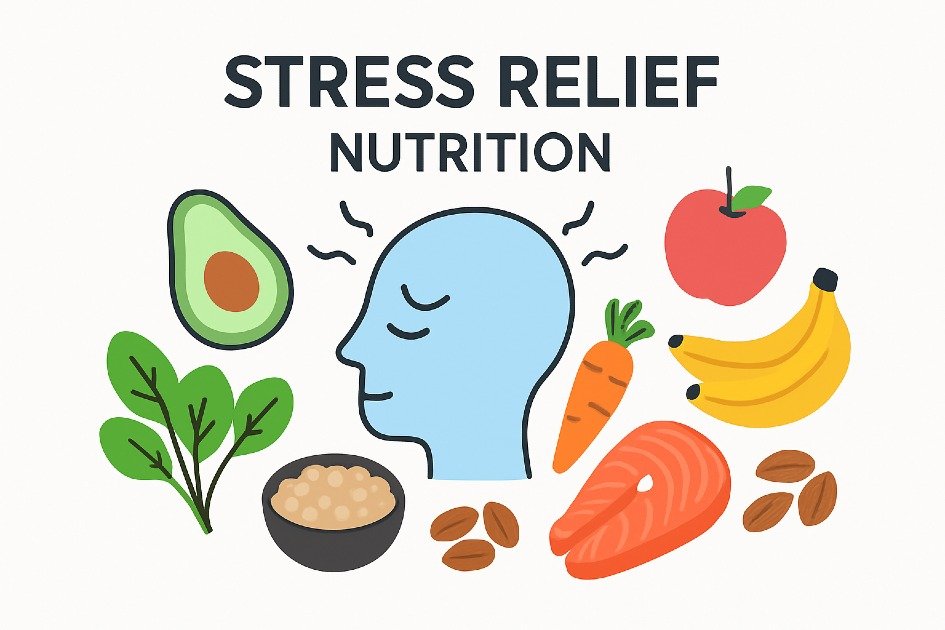
The Power of Nutrition for Stress Relief
Nutrition plays a crucial role in stress relief and mood, shaping energy and resilience. It influences hormones, inflammation, and neurotransmitters, enabling individuals to navigate pressure with clarity and calm.
Foods That Naturally Calm the Nervous System
Why it matters:
Certain foods contain nutrients that support the nervous system, regulating stress hormones like cortisol and balancing mood-enhancing chemicals like serotonin, enabling the body to respond to stress effectively.
How to do it:
- Eat omega-3 foods like salmon, walnuts, chia seeds, and flaxseeds fight because they soothe inflammation and boost brain health.
- Eat magnesium-rich foods like spinach, pumpkin seeds, and almonds to relax my muscles and calm my mind.
- Incorporating complex carbs like oats, quinoa, and sweet potatoes to keep blood sugar steady and reduce mood swings and anxiety.
- Eating blueberries and dark chocolate gives antioxidants that fight stress and lift your mood naturally.
- Add turmeric, ginger, and rosemary to your meals. They fight inflammation and boost brain focus.
I add nuts and leafy greens to my meals to calm my stress and keep my body strong against daily challenges.
Hydration Habits That Keep Stress Levels in Check
Why it matters:
Mild dehydration can increase cortisol and tension, while staying hydrated support’s cognitive function, improves digestion, and maintains energy levels, aiding effective stress management.
How to do it:
- Set water alarms on your phone or smart bottle to drink regularly and stay hydrated all day.
- Flavor your water naturally by dropping in cucumber, lemon, or mint for a fresh, sugar-free boost.
- Replace sugary drinks with herbal teas like chamomile or peppermint to stay hydrated and ease anxiety naturally.
- Drink at least eight cups (64 oz) of water daily, more if you exercise or it is hot outside.
I sip water throughout the day, turning hydration into a calm, mindful habit. It soothes my nerves and sharpens my mind without any extra effort.
Limiting Caffeine and Sugar for a Steadier Mind
Why it matters:
High caffeine and sugar intake can cause rapid blood sugar spikes and crashes, intensifying stress responses and overstimulating adrenal glands, increasing body sensitivity to tension and anxiety.
How to do it:
- Keep caffeine light. One morning cup is fine but skip coffee or energy drinks later in the day.
- Pick whole foods, not sugary snacks. Grab fruit, nuts, or Greek yogurt instead of candy or pastries.
- Check Labels Carefully. Sugars often hide in sauces, cereals, and drinks, adding extra calories without you noticing.
- Pair sweets with protein or fiber to slow sugar absorption and prevent sudden spikes.
When I cut back a little on caffeine and sugar, I feel calmer in my day. I do not give them up completely, I just keep them in balance. This small choice helps my body stay steady and keeps stress from taking over.
Making Nutrition a Daily Stress Relief Habit
Why it matters:
Inconsistent food choices can hinder health, so incorporating nutrition into stress relief habits can provide long-term benefits for both body and mind.
How to do it:
- Prep your meals ahead of time. Choose easy, nutrient-packed foods so you will not grab unhealthy options when stress hits.
- Eat an omega-3 food each day or drink water as soon as you wake up.
- Keep smart snacks such as nuts, fruit, or dark chocolate nearby to fight stress and avoid overeating.
- Eat with awareness: slow down, enjoy each bite, and notice how your food changes your mood and energy.
When I treat food as part of my stress relief, eating feels less like a routine and more like a way to stay calm and strong. Every bite helps me find balance.
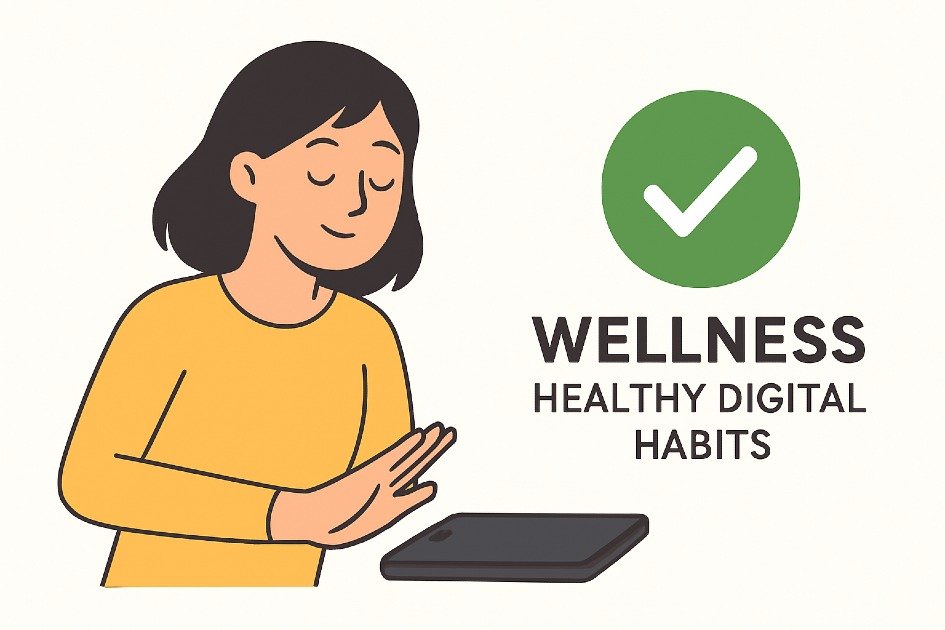
Building Healthy Digital Boundaries
Screens can raise stress, break focus, and cloud the mind. Setting digital boundaries helps you stay calm, mindful, and emotionally strong.
Reducing Screen Time to Protect Mental Energy
Why it matters:
Too much screen time can raise stress levels and make it harder to sleep well. Reducing digital exposure can help regain mental clarity and emotional equilibrium, turning technology into a tool.
How to do it:
- Track your screen time for a week. Knowing where your hours go online is the first step to making better choices.
- Limit apps by turning on tools like Screen Time to set daily use caps and stay in control.
- Set tech-free times: Begin with 30 minutes at dinner or before bed to build a simple, healthy habit.
- Trade screen time for calm. Take a walk, write in a journal, or try meditation instead of scrolling.
How Social Media Detoxes Create Mental Space
Why it matters:
Social media can trigger anxiety, information overload, and stress, while regular detoxes refresh the mind, improve mood, and redirect cognitive energy towards productive tasks.
How to do it:
- Pick your pace. Begin with one day or a weekend detox, then slowly extend as you feel ready.
- Tell your friends you are taking a short break, so you do not feel pressured to check messages all the time.
- Swap stress with a healthy habit. Read, breathe deeply, or enjoy a hobby you love.
- Check how you feel afterward. Notice boosts mood, energy, and focus. Seeing the benefits keeps you motivated.
Creating a Relaxing Tech-Free Evening Routine
Why it matters:
Screen blue light disrupts sleep, causing restlessness. A tech-free nightly routine promotes relaxation, improves sleep quality, and reduces stress, making it a valuable stress relief method.
How to do it:
- Pick a time to stop using devices—try one hour before bed for better sleep.
- Create calm moments. Light a candle, play soft music, or follow a short, guided meditation.
- Charge your phone outside the bedroom to stop late-night scrolling and sleep better.
- Write down your thoughts. Journaling clears your mind and helps you relax before sleep.
Mindful Notifications: Regaining Control Over Alerts
Why it matters:
Controlling constant notifications can prevent stress spikes and restore focus, reinforcing stress relief habits by reducing unnecessary triggers.
How to do it:
- Switch off unnecessary app notifications to stay focused and reduce stress.
- Set specific times to check texts and emails instead of replying right away.
- Silence notifications during work, meals, or quiet time by turning on ‘Do Not Disturb’ to stay focused and relaxed.
- Place sticky notes or use digital planners to guide your focus instead of relying on constant alerts.
Designing Workspaces That Support Digital Balance
Why it matters:
A well-designed workspace promotes focus, creativity, and calmness, reducing stress and promoting a healthy work-life balance by incorporating boundaries and clear communication.
How to do it:
- Create clear work and rest spaces. Do not bring laptops or work devices into areas where you relax.
- Tidy your desk, organize cables, and clear your screens.
- Add plants or let in sunlight. Nature boosts mood and eases stress.
- Take regular screen breaks. Pause every 60–90 minutes to refresh your mind and energy.
I set healthy digital boundaries by cutting screen time, taking tech breaks, and keeping my evenings device-free. This helps me stay focused, feel calmer, and protect my energy.
Recap: Embracing a Calmer Way of Living
Consistent Stress Relief Habit practices can lead to a calmer, more centered life.
These habits, such as mindful breathing and digital detoxes, function as touchstones, reminding us that peace is always within reach.
Harvard Health reports that 20 minutes of natural setting exposure can significantly reduce stress, with a study showing that engaging with nature for 10 minutes or more three times a week decreases cortisol levels.
By incorporating these habits into our daily routine, we can build a sanctuary around our minds, reducing tension and making life’s challenges manageable.
By committing to these habits, we can become more resilient and centered, allowing our minds, bodies, and souls to experience moments of peace and tranquility.
Frequently Asked Questions
What are the fastest ways to relieve stress in the moment?
Quick interventions like deep breathing, grounding exercises, or walking can prevent tension spikes. A simple stress relief habit, paired with herbal tea or soundscapes, can calm the nervous system in minutes. Consistency is key.
How can I tell if my stress is becoming unhealthy?
Chronic stress can cause physical and emotional symptoms like headaches, muscle tightness, sleep disruption, irritability, and difficulty focusing. Recognizing these cues and incorporating structured stress relief habits can mitigate long-term effects.
Is exercise always the best way to relieve stress?
Physical activity is effective, but gentle movements like yoga and tai chi provide a calmer alternative. Mindful movement helps release tension, reset energy, and enhance mental clarity.
Can small daily habits really make a big difference?
Minimal, deliberate actions like mindfulness and gratitude can significantly improve stress management, reshape daily responses and foster a more stable emotional baseline.
How do I stay consistent with stress relief practices?
Anchor stress relief habits to routines, use reminders, track habits, and have accountability partners for consistent adherence, focusing on steady progress rather than perfection.
Are there tools or products that enhance stress relief habits?
Establish stress relief routines, use reminders, track habits, and have accountability partners for consistent adherence, focusing on steady progress over perfection.
How long before a stress relief habit shows results?
Practiced daily stress relief habits, such as breathing exercises, journaling, meditation, or consistent movement, can lead to measurable improvements in mood, energy, and focus.
Can stress relief habits improve physical health too?
Chronic stress negatively impacts cardiovascular health, immunity, and digestion. Mindful breathing, stretching, and meditation can reduce inflammation, lower blood pressure, and enhance overall wellness, promoting emotional and physical resilience.
What if I do not have time for lengthy stress relief routines?
Consistent practice of brief, effective stress relief habits like breathing exercises, journal entries, or short walks can accumulate into a significant stress buffer over time.
Can stress relief habits work alongside therapy or medication?
Stress management practices complement professional treatment, enhancing therapeutic outcomes and emotional regulation. Consult a healthcare provider before combining supplements or routines with prescribed treatments.

